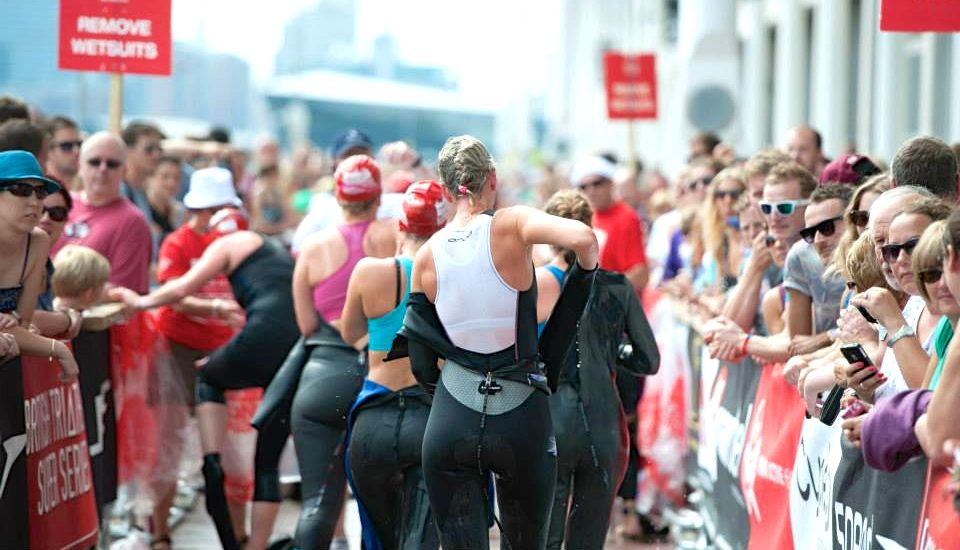Blog: which is tougher – racing an Olympic tri or marshalling one?
Ever wondered what it’s like to be a race marshal? We take a look…

They’re the unsung heroes of triathlons – but how does a race marshal’s day differ from the athletes? TFN TRI club member Sandra Lee takes a humorous look at the recent Dambuster…
The alarm call for the athlete involves waking up at 4am to eat porridge and travel to the venue. The alarm call for the marshal team involves stamina after partying all night – well the beer was free!
Nutrition before the race is particularly important, the athletes are consuming gels, water and energy drinks. At the other end of the spectrum the marshall team receive greasy bacon butty’s and dreadful tea provided from the Scouts tent plus a packed lunch supplied by the organiser (all eaten by 9am ‘cause you’re too busy afterwards).
Next, athletes set up for the race and complete the various final checks, rack and check the bike, lube up and finally squeeze into their wetsuit. There’s a more relaxed start for the marshals who collect their t-shirt/hoodie/gilet, packed lunch and high-vis jacket and either sit in the back of the van in between barrels of energy drink in the pitch black or walk several miles to their posts. They’ll then spend two hours checking numbers and telling people the same information over and over and over and over…
Race start
Race time, athletes contend with the cold water swim and being on the wrong end of a few nasty punches. The marshals meanwhile shout at people blocking the swim exit, and get goggles thrown at them as the athletes finish the swim.

T1 – the athlete attempts to not look silly here, while removing their wetsuit and trying not to fall over, and then mounting their bike without falling off. At this stage marshals stand back and laugh at people falling over and off their bikes, but on occasions must deal with people landing on them. Not forgetting to shout at people who can’t see the mount line.
The bike stage means head down and pedal hard for the athletes. Meanwhile the marshals set up the feed station, which brings with it the traditional argument over how much nutrition drink to mix in. The first few riders come through and immediately changes are made to the layout of the feed station. Interesting encounters then occur with the cyclists who wish to take a bottle at 25mph. Consequently marshals lose their arms and then get shouted at by cyclists who miss the bottle because they wouldn’t slow down.
Shout ‘High 5’ or ‘Water’ and your voice becomes hoarse and then getting extremely dehydrated because you don’t have time to drink yourself. Fingers go numb filling the water bottles, but awareness is key to be able to dodge the incoming empty water bottle missiles. Collect the water bottles/cups/gel wrappers from then on in the 1km radius they have landed in. While this is all going on don’t forget to cheer!
T2 – Approaching the final stage and the athletes change shoes, remembering to remove their helmet. The marshal’s job at this transition is to shout at people to dismount BEFORE the line and catch any bikes that run into them.
Into the run and athletes experience jelly legs whilst trying to look good when they pass the marshals and supporters. With the finish line in sight, the athletes just need to hang on. By now the hangover is setting in for the marshals and the last feed station needs setting up.
Shouting ‘High 5’ or ‘Water’ again until you are hoarse and then getting shouted at by runners this time who miss the drinks because they wouldn’t slow down. More numb fingers and more dodging of unfinished drinks and empty cups. Still don’t forget to cheer!

Other roles for marshals on the day include: standing by gates and crossings shouting at general public who are oblivious to runners; trying to think up new encouraging things to shout to people you’ve seen three times already for motivation and then trying not to take offence when runners declare that they don’t ever want to see you again.
Finally, go berserk when you see anyone in TFN kit (who generally ignore you as they have their game faces on) but don’t forget to fend sheep off who try to trip runners up.
Post-race tasks
It’s all over! The athletes relax, have a massage, revel in their glory, wear and admire their new t-shirt and then wait an eternity for the last runner to come through. As a marshal your final task is to pack up the feed station and walk 2km back to the finish collecting rubbish.
Total time: 2.5 – 3 hours (athletes) / 7 hours (race marshals)
Hero status:Superman (athletes) / Clark Kent (race marshals)
Verdict
Racing is hard work but there are rewards including a t-shirt and many hero points, and the faster you go, the quicker you can stop. It becomes addictive as you want to beat your times.
Marshalling is a lot more sociable – you leave with free stash (often better than the race stuff), a season’s supply of gels and energy drink and no voice at all (not to mention tired and hungover). You have to work all day with no breaks, often in the cold, get zero hero points but rarely stop laughing and smiling all day and you leave with a warm glow knowing you’ve helped hundreds of likeminded people have a great race.
(Main image: TriSpirit Events)
Have you experienced marshalling a triathlon event? If so, how did you find it? Let us know in the comments below!



